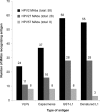Identification of B-cell epitopes on virus-like particles of cutaneous alpha-human papillomaviruses
- PMID: 19793806
- PMCID: PMC2786864
- DOI: 10.1128/JVI.01582-09
Identification of B-cell epitopes on virus-like particles of cutaneous alpha-human papillomaviruses
Abstract
Human papillomavirus (PV) (HPV) types 2, 27, and 57 are closely related and, hence, represent a promising model system to study the correlation of phylogenetic relationship and immunological distinctiveness of PVs. These HPV types cause a large fraction of cutaneous warts occurring in immunocompromised patients. Therefore, they constitute a target for the development of virus-like particle (VLP)-based vaccines. However, the immunogenic structure of HPV type 2, 27, and 57 capsids has not been studied yet. Here we provide, for the first time, a characterization of the B-cell epitopes on VLPs of cutaneous alpha-HPVs using a panel of 94 monoclonal antibodies (MAbs) generated upon immunization with capsids from HPV types 2, 27, and 57. The MAbs generated were characterized regarding their reactivities with glutathione S-transferase-L1 fusion proteins from 18 different PV types, the nature of their recognized epitopes, their isotypes, and their ability to neutralize HPV type 2, 27, 57, or 16. In total, 33 of the 94 MAbs (35%) showed type-specific reactivity. All type-specific MAbs recognize linear epitopes, most of which map to the hypervariable surface loop regions of the L1 amino acid sequence. Four of the generated MAbs neutralized pseudovirions of the inoculated HPV type efficiently. All four MAbs recognized epitopes within the BC loop, which is required and sufficient for their neutralizing activity. Our data highlight the immunological distinctiveness of individual HPV types, even in comparison to their closest relatives, and they provide a basis for the development of VLP-based vaccines against cutaneous alpha-HPVs.
Figures





Similar articles
-
Hybrid papillomavirus L1 molecules assemble into virus-like particles that reconstitute conformational epitopes and induce neutralizing antibodies to distinct HPV types.Virology. 2001 Dec 20;291(2):324-34. doi: 10.1006/viro.2001.1220. Virology. 2001. PMID: 11878901
-
Identification of two cross-neutralizing linear epitopes within the L1 major capsid protein of human papillomaviruses.J Virol. 2002 Jul;76(13):6480-6. doi: 10.1128/jvi.76.13.6480-6486.2002. J Virol. 2002. PMID: 12050360 Free PMC article.
-
Identification of type-specific and cross-reactive neutralizing conformational epitopes on the major capsid protein of human papillomavirus type 31.Arch Virol. 2006 Aug;151(8):1511-23. doi: 10.1007/s00705-006-0734-y. Epub 2006 Mar 3. Arch Virol. 2006. PMID: 16508703 Free PMC article.
-
Developments in L2-based human papillomavirus (HPV) vaccines.Virus Res. 2017 Mar 2;231:166-175. doi: 10.1016/j.virusres.2016.11.020. Epub 2016 Nov 23. Virus Res. 2017. PMID: 27889616 Free PMC article. Review.
-
Papillomavirus-like particle vaccines.J Natl Cancer Inst Monogr. 2001;(28):50-4. doi: 10.1093/oxfordjournals.jncimonographs.a024258. J Natl Cancer Inst Monogr. 2001. PMID: 11158207 Review.
Cited by
-
Characterization of monoclonal antibodies specific for the Merkel cell polyomavirus capsid.Virology. 2010 Sep 15;405(1):20-5. doi: 10.1016/j.virol.2010.06.022. Epub 2010 Jul 3. Virology. 2010. PMID: 20598728 Free PMC article.
-
Prediction of B-cell linear epitopes with a combination of support vector machine classification and amino acid propensity identification.J Biomed Biotechnol. 2011;2011:432830. doi: 10.1155/2011/432830. Epub 2011 Aug 23. J Biomed Biotechnol. 2011. PMID: 21876642 Free PMC article.
-
Multivalent human papillomavirus l1 DNA vaccination utilizing electroporation.PLoS One. 2013;8(3):e60507. doi: 10.1371/journal.pone.0060507. Epub 2013 Mar 25. PLoS One. 2013. PMID: 23536912 Free PMC article.
-
Next generation L2-based HPV vaccines cross-protect against cutaneous papillomavirus infection and tumor development.Front Immunol. 2022 Oct 3;13:1010790. doi: 10.3389/fimmu.2022.1010790. eCollection 2022. Front Immunol. 2022. PMID: 36263027 Free PMC article.
-
Identification and localization of minimal MHC-restricted CD8+ T cell epitopes within the Plasmodium falciparum AMA1 protein.Malar J. 2010 Aug 24;9:241. doi: 10.1186/1475-2875-9-241. Malar J. 2010. PMID: 20735847 Free PMC article.
References
-
- Akgül, B., J. C. Cooke, and A. Storey. 2006. HPV-associated skin disease. J. Pathol. 208:165-175. - PubMed
-
- Bradford, M. M. 1976. A rapid and sensitive method for the quantitation of microgram quantities of protein utilizing the principle of protein-dye binding. Anal. Biochem. 72:248-254. - PubMed
-
- Bryan, J. T. 2007. Developing an HPV vaccine to prevent cervical cancer and genital warts. Vaccine 25:3001-3006. - PubMed
-
- Buck, C. B., and C. D. Thompson. 2007. Production of papillomavirus-based gene transfer vectors. Curr. Protoc. Cell Biol. 37:26.1.1-26.1.19. - PubMed
Publication types
MeSH terms
Substances
LinkOut - more resources
Full Text Sources
Other Literature Sources
Research Materials

